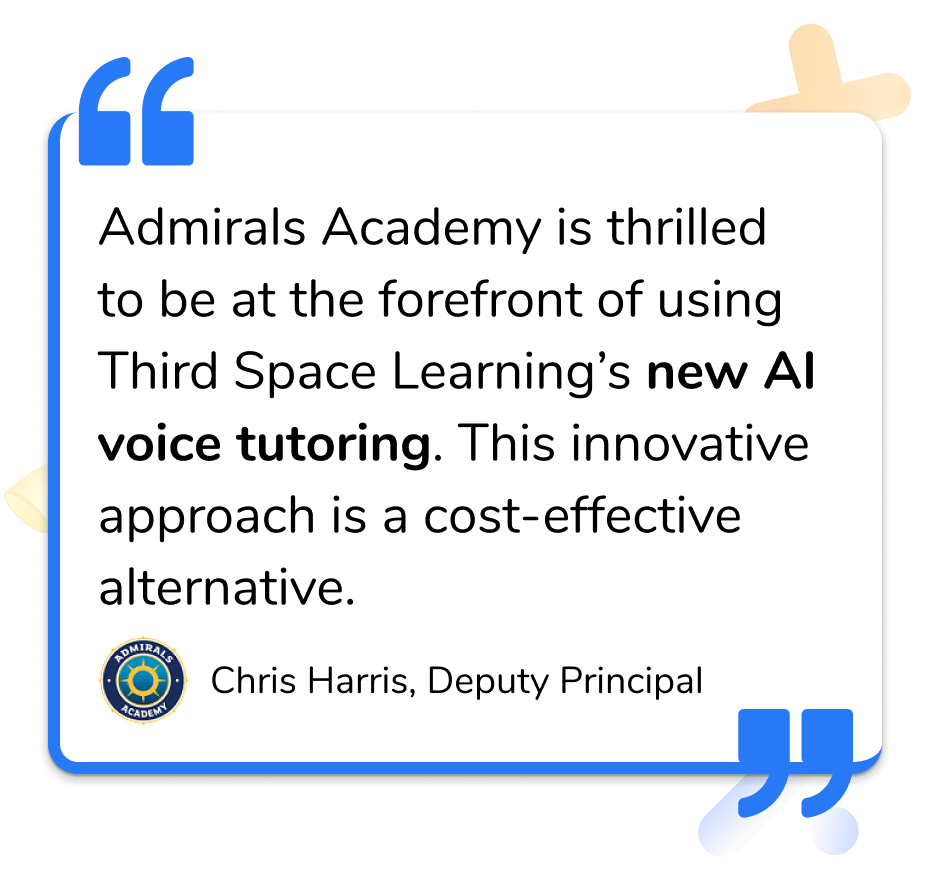FIFTH GRADE MATH TUTORING
Close math gaps in 5th grade before they grow
5th graders need plenty of opportunities to practice the math skills they struggle with and to ensure they’re well prepared for the challenges of middle school math.
It’s not always easy to give fifth graders the tailored math help they need to keep up.
Provide fifth grade students opportunities to consolidate math concepts and practice math problems with personalized online 5th grade math tuition with a dedicated math tutor.
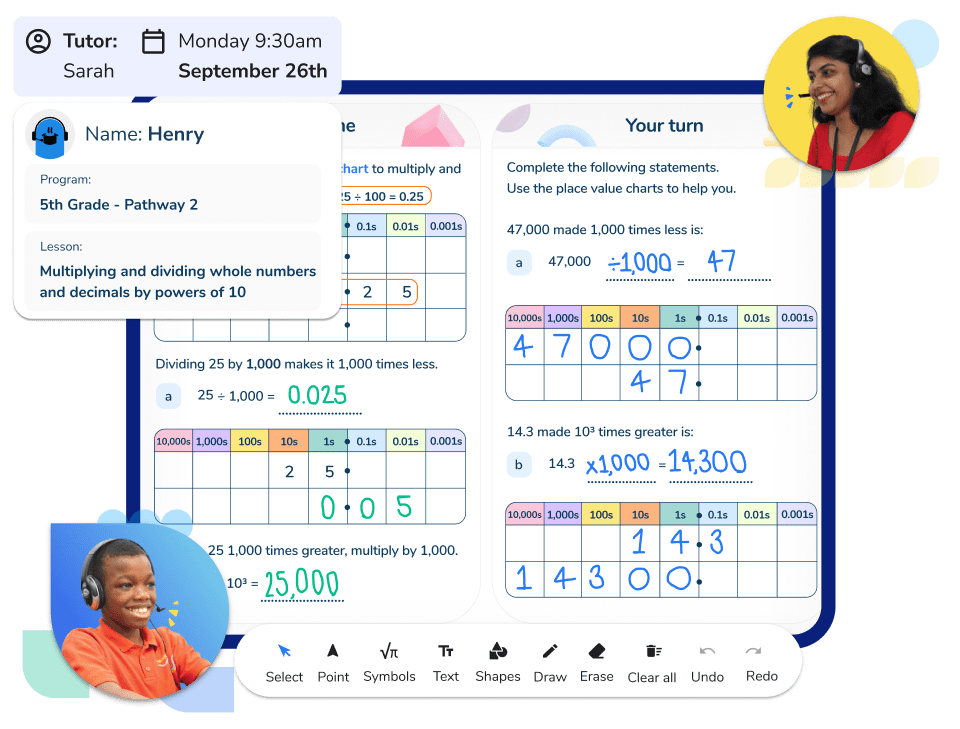
I love that the tutoring sessions are tailored to meet the specific needs of the individual and that the children have the same tutor for every session so that the pace of the math lesson suits the individual.
Valda Varadinek-Skelton
Math Lead
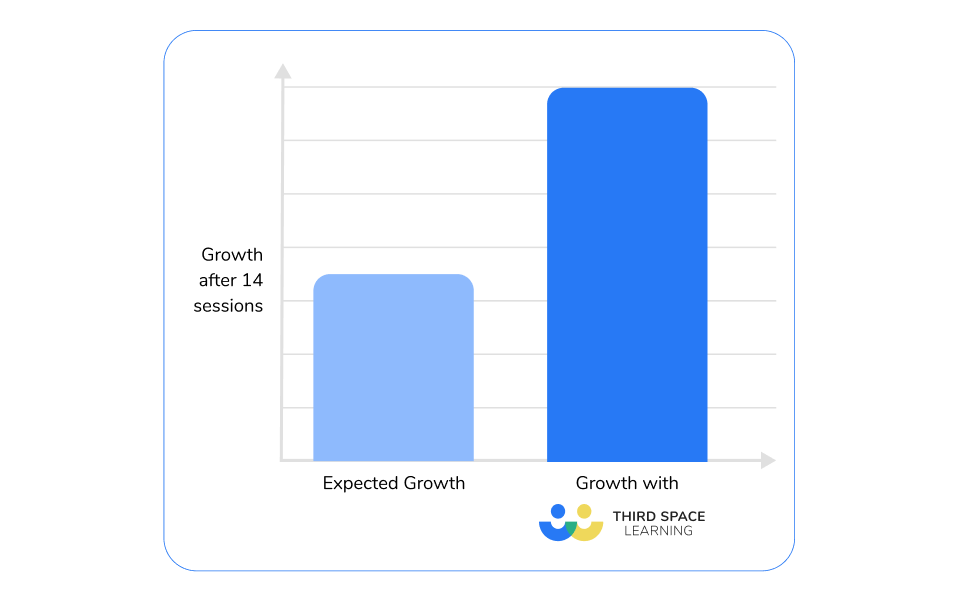
Benefits of 5th Grade Math Tutoring
Tutoring for fifth graders has a greater impact on student progress than starting in middle school or even high school.
A 5th grade math tutoring program helps learners gain a better understanding of math concepts before and boosts math achievement.
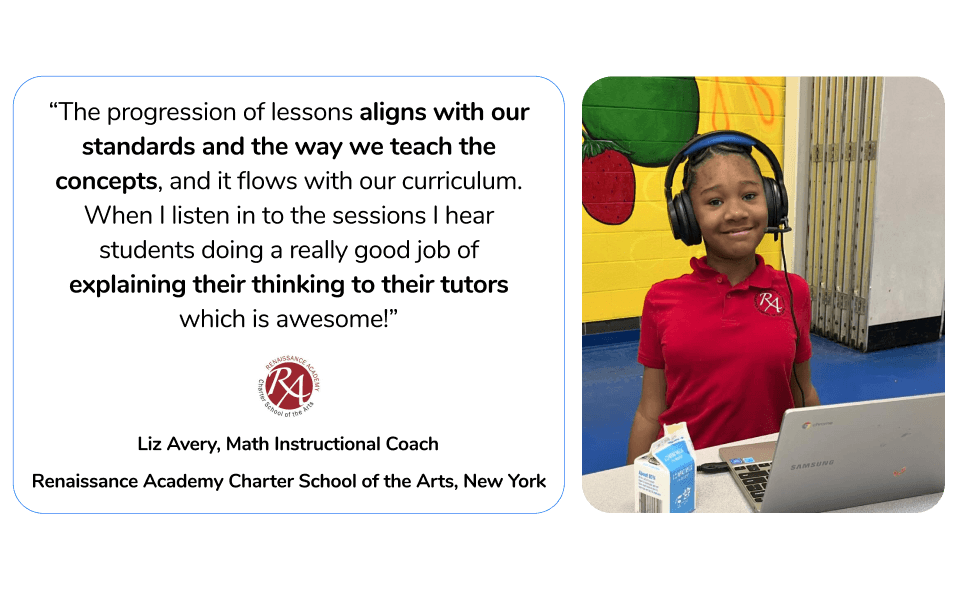
Develop problem solving
5th graders are consolidating their elementary math skills ready for more complex problem-solving and multi-step word problems in 6th grade.
One-on-one online tutoring sessions provide extra math opportunities for fifth graders struggling to keep up with math lessons and more difficult math concepts ahead of middle school.
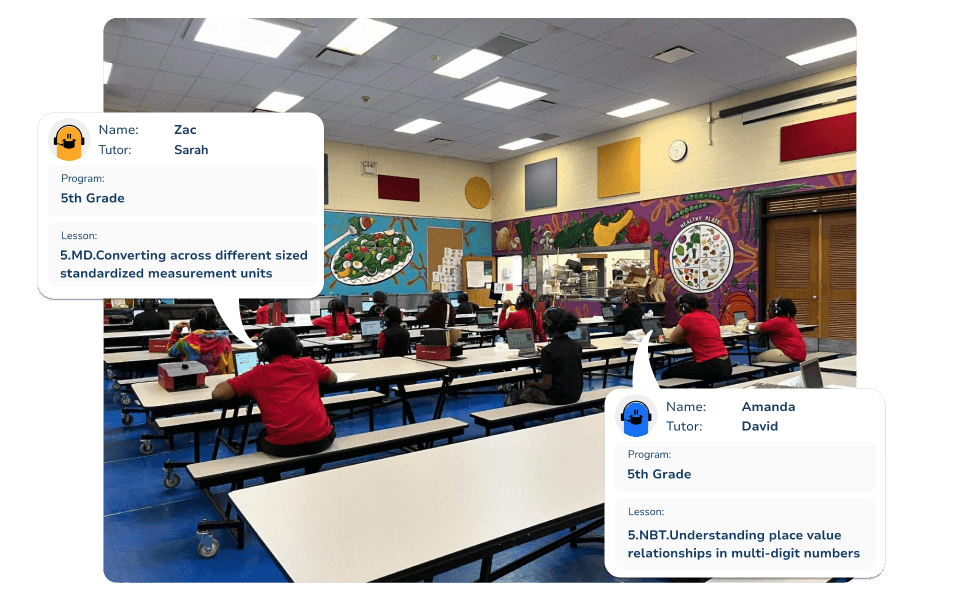
Individualized tutoring service
Often, 5th graders benefit from different teaching styles but differentiating worksheets for a whole class can be challenging.
Each student works one-on-one with an online tutor who adapts instructions and math lesson content in real-time according to the student’s needs.
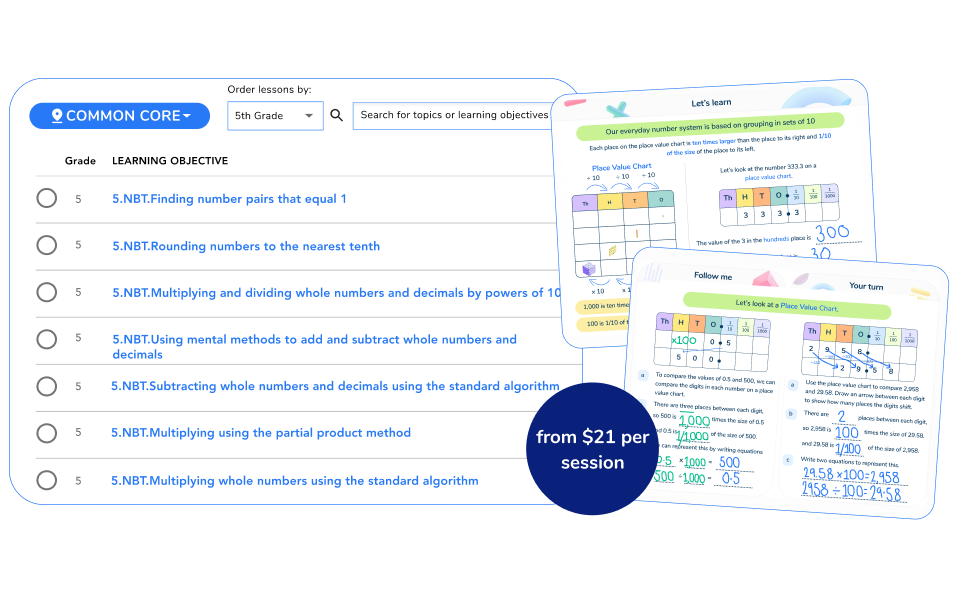
Expert 5th grade math tutoring
All math lesson plans are created by a team of math teachers and cover the fifth grade standards for every US state and Common Core.
Third Space Learning’s 5th grade tutors are STEM specialists — it’s like bringing in multiple high-quality interventionists into your elementary school for 5th grade without the price tag.
Preview 5th grade math tutoring lessons
Preview 5th grade math tutoring lessons
Specially created lessons designed to build conceptual understanding and enable tutors to respond to students’ needs in real-time:
-
Example lesson 1
-
Example lesson 2
-
Example lesson 3
Comparing and ordering numbers with up to 3 decimal places
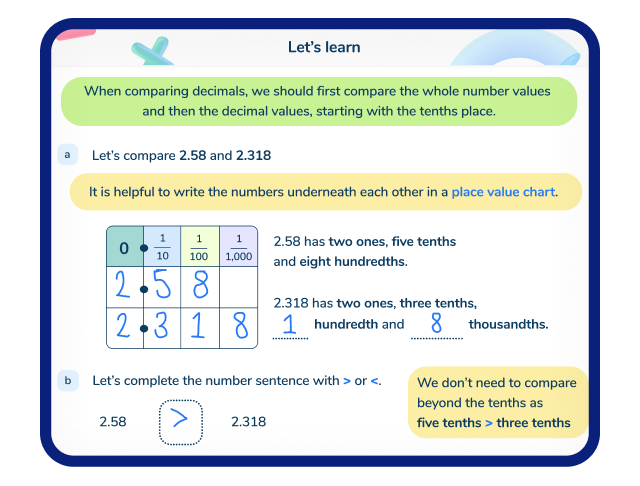
Let’s learn
The first question introduces each concept and helps students feel ready to learn
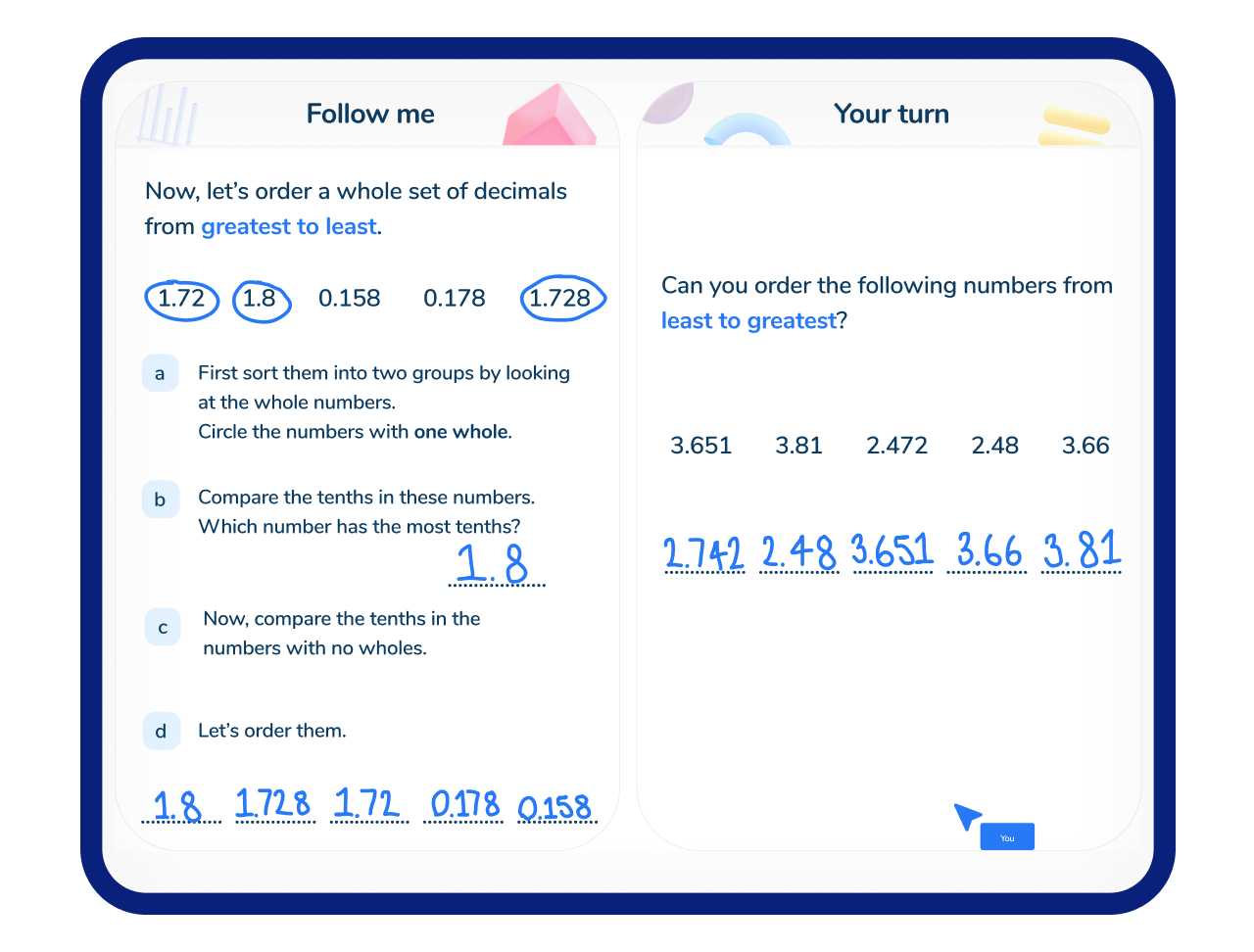
Follow me + your turn
Students work through a scaffolded example with their tutor before trying a similar question on their own
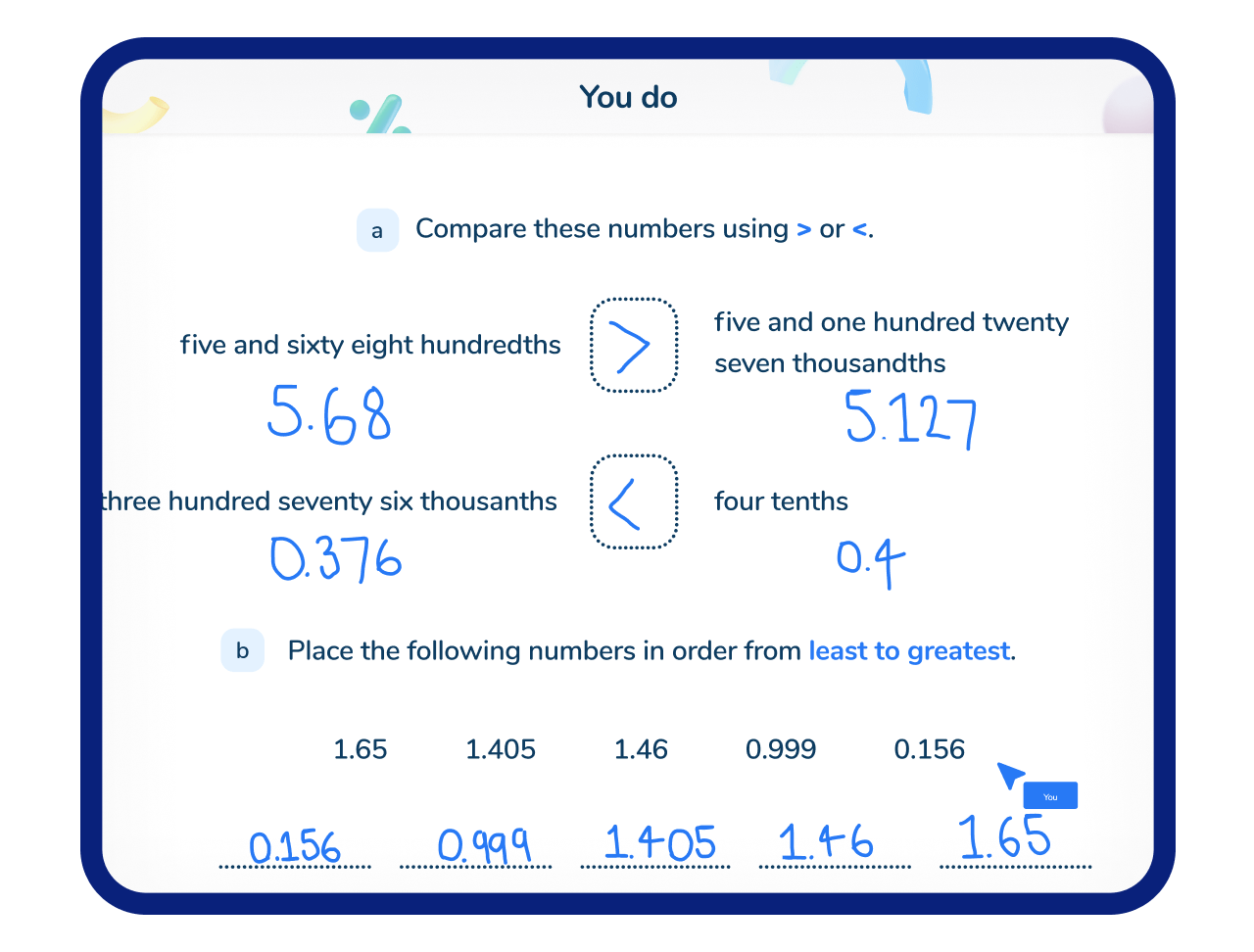
You do
A carefully sequenced next question ensures students can apply knowledge to different contexts
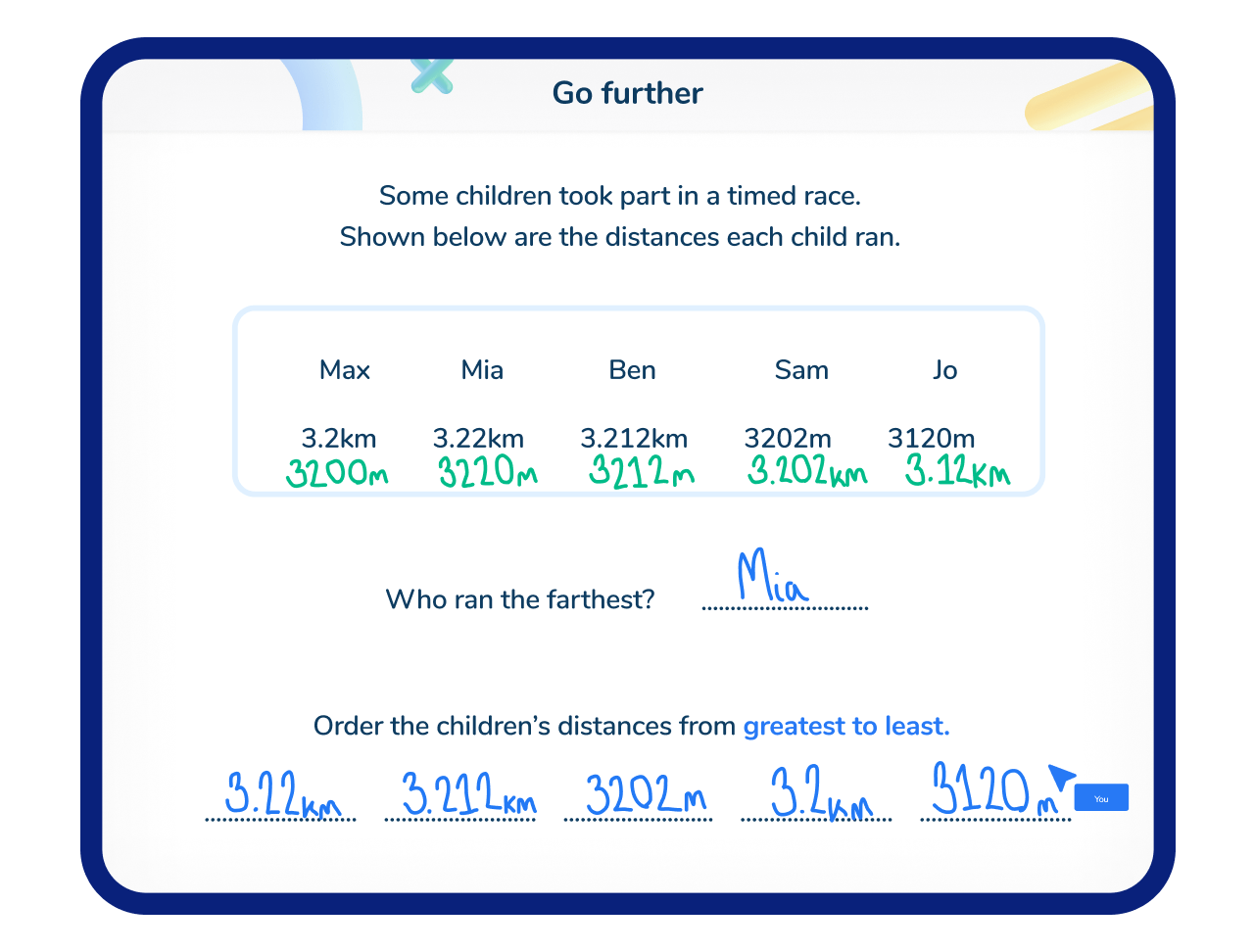
Go further
This gives students an opportunity to apply their knowledge to problem solving and reasoning questions
Understanding place value relationships in multi-digit numbers
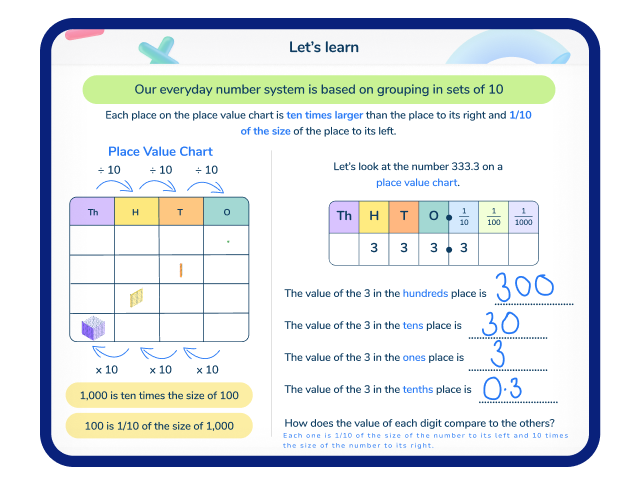
Let’s learn
The first question introduces each concept and helps students feel ready to learn
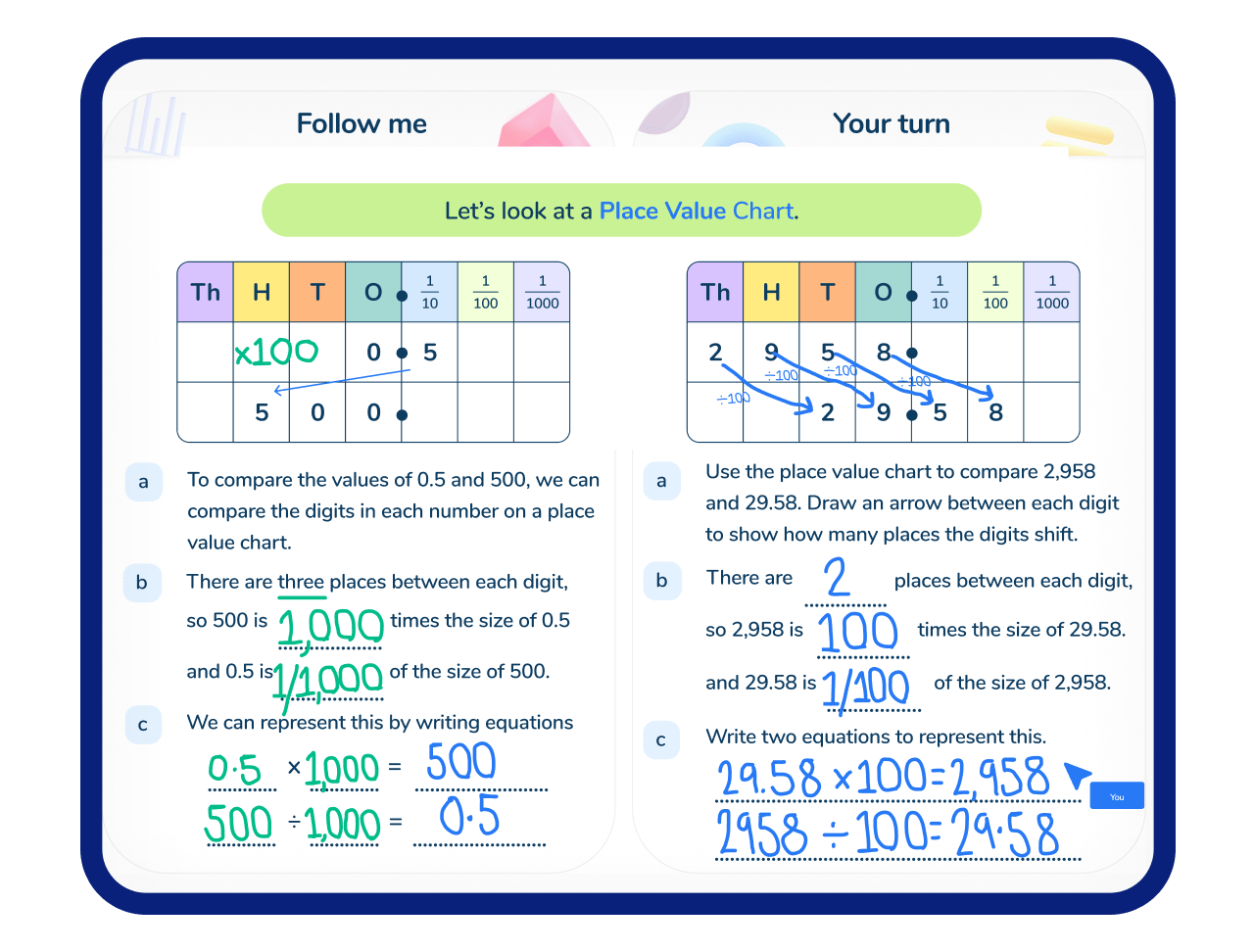
Follow me + your turn
Students work through a scaffolded example with their tutor before trying a similar question on their own
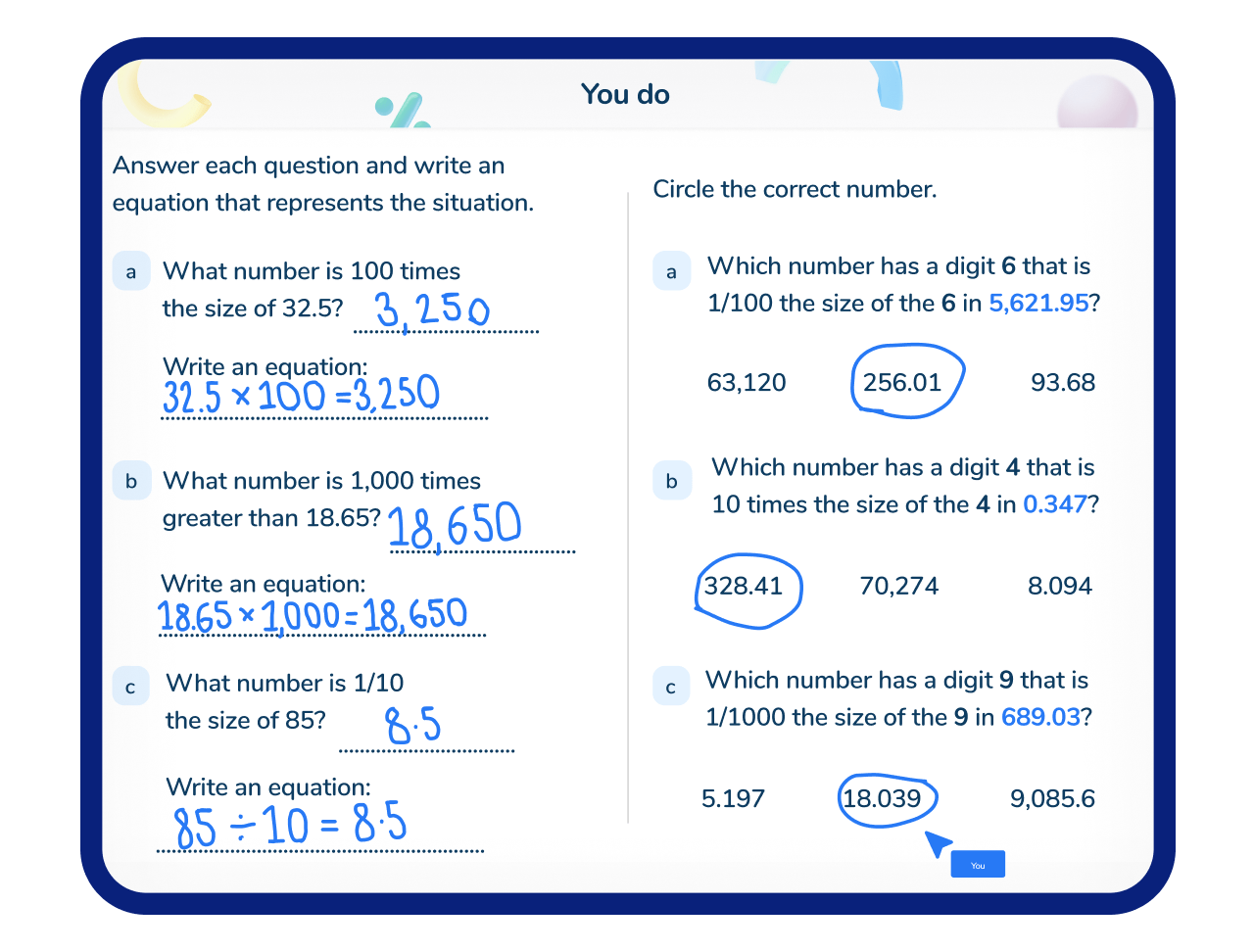
You do
A carefully sequenced next question ensures students can apply knowledge to different contexts
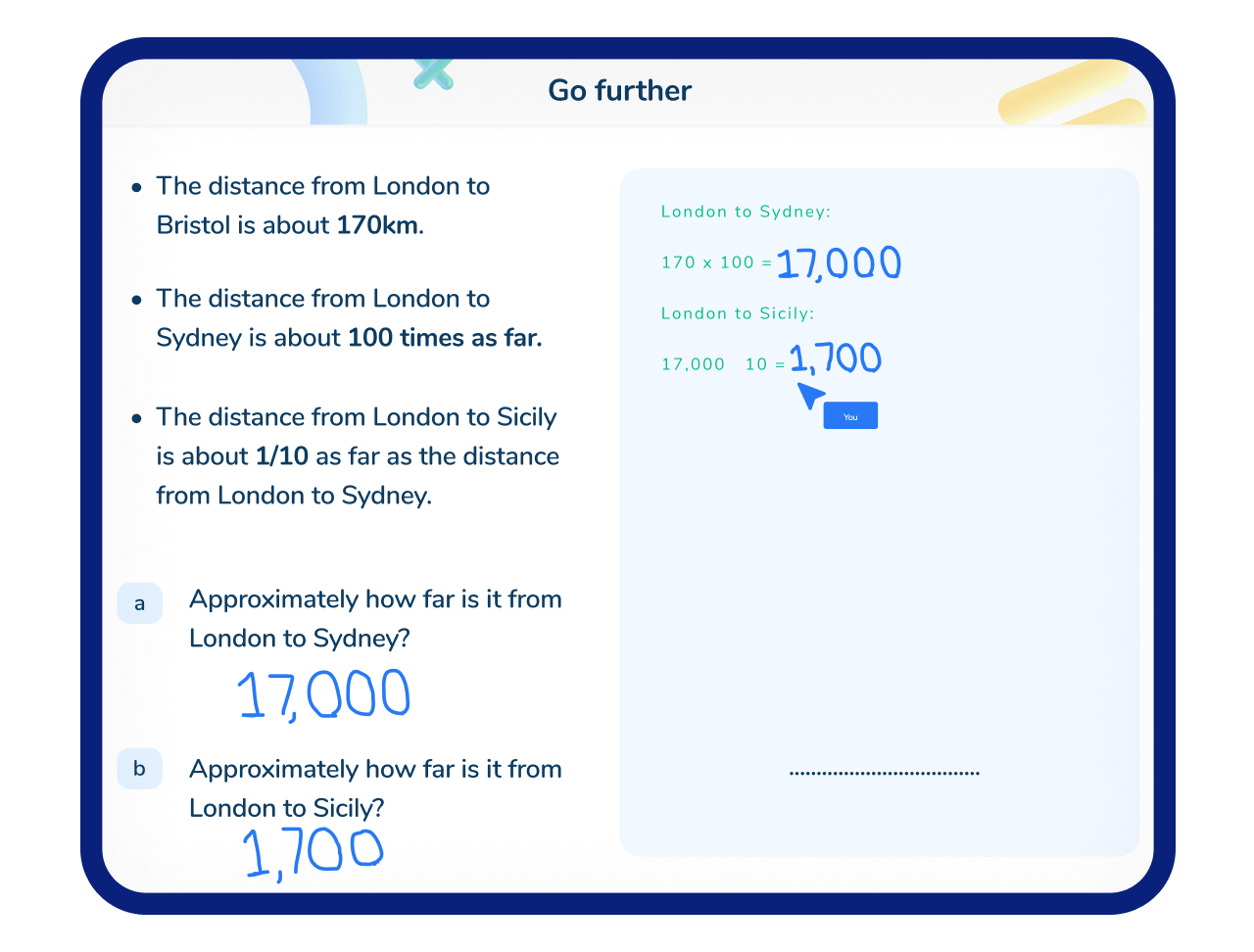
Go further
This gives students an opportunity to apply their knowledge to problem solving and reasoning questions
Multiplying and dividing whole numbers and decimals by powers of 10
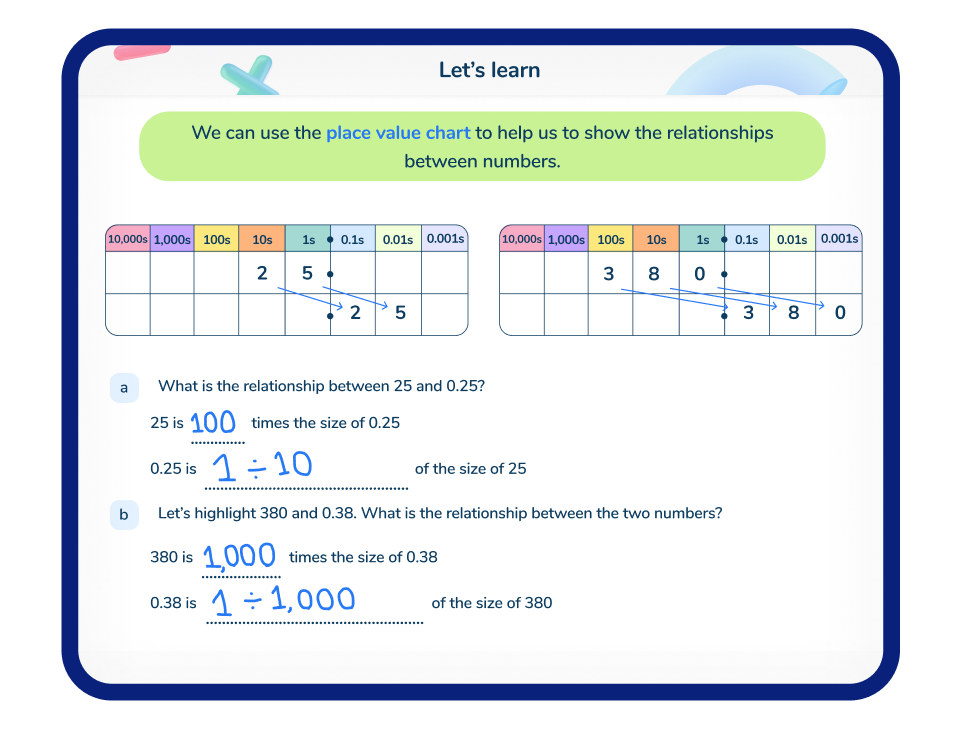
Let’s learn
The first question introduces each concept and helps students feel ready to learn
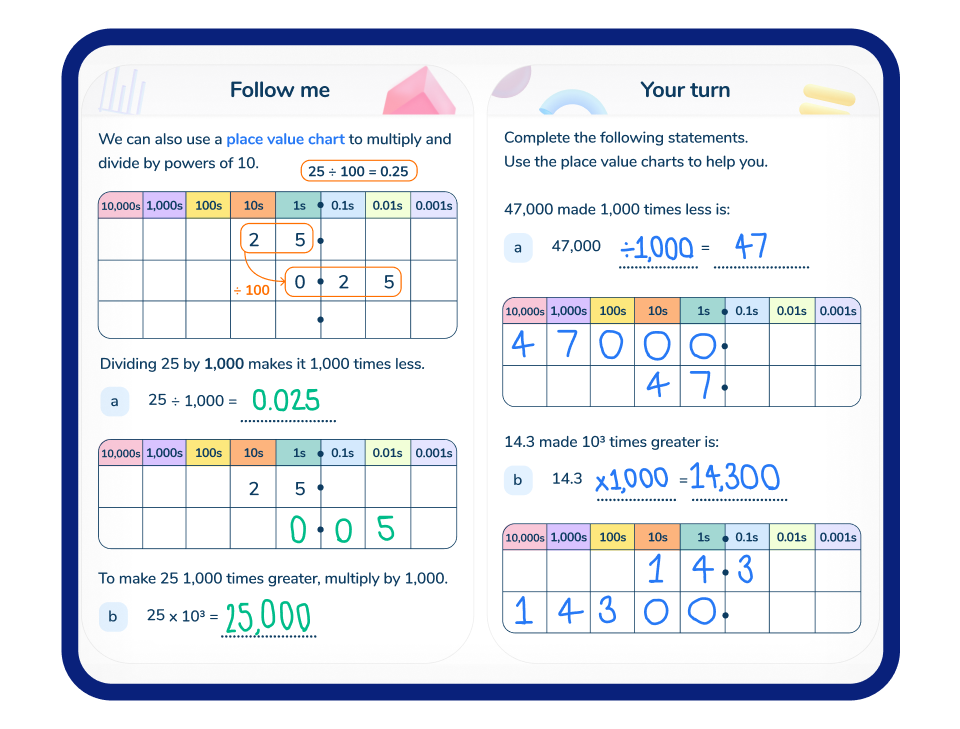
Follow me + your turn
Students work through a scaffolded example with their tutor before trying a similar question on their own
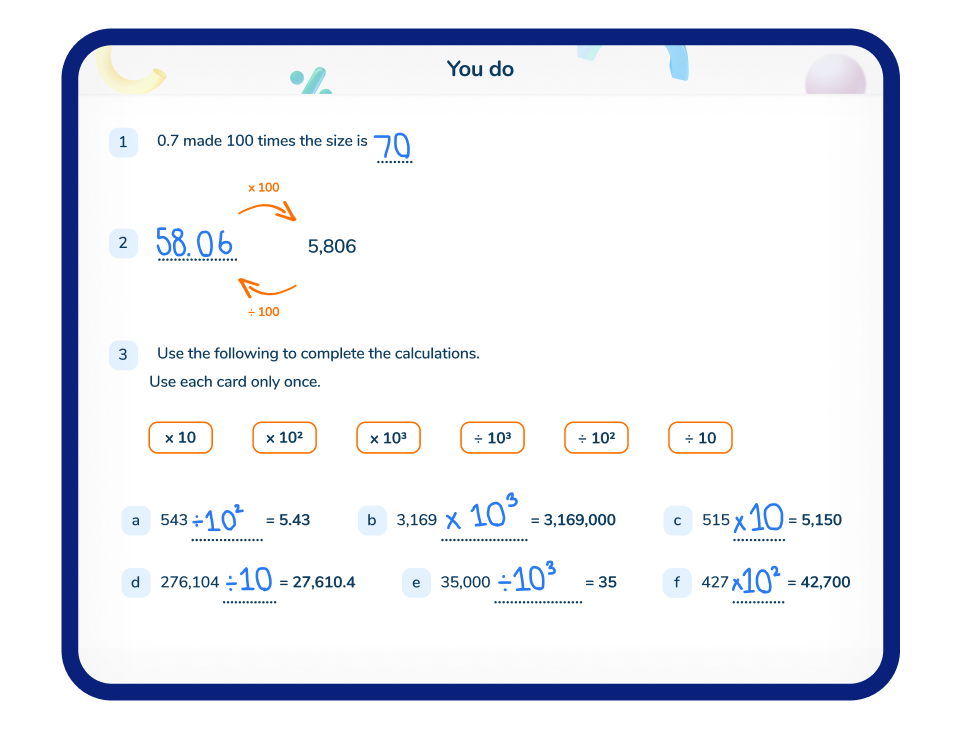
You do
A carefully sequenced next question ensures students can apply knowledge to different contexts
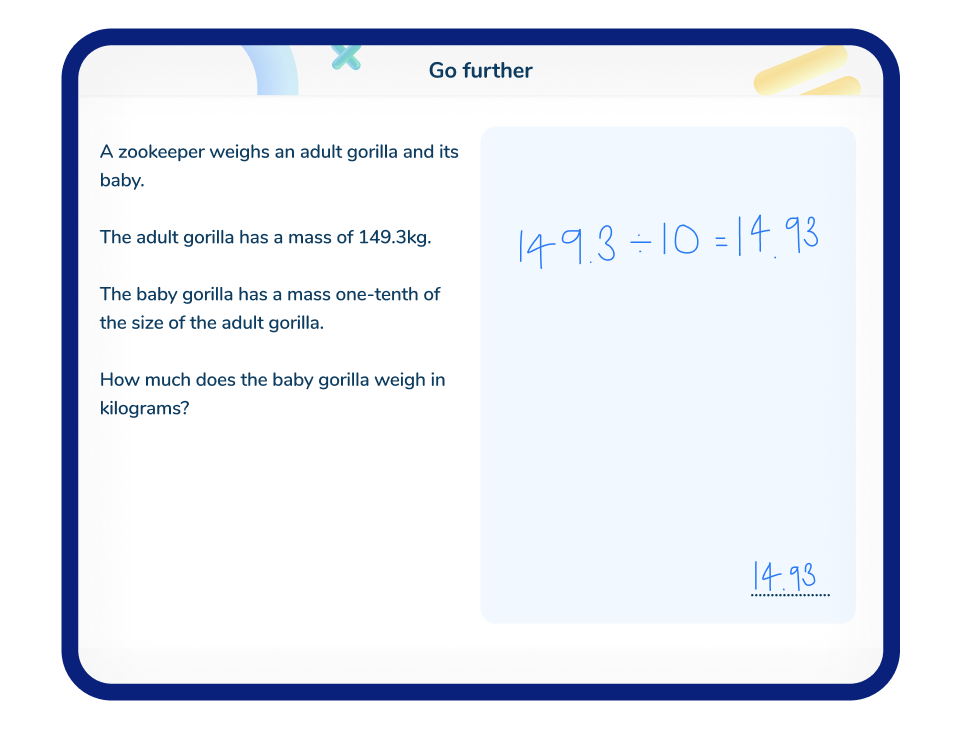
Go further
This gives students an opportunity to apply their knowledge to problem solving and reasoning questions
5th grade scope and sequence
Whether you have students who would benefit from more opportunities to practice 5th grade standards or who have existing gaps from previous grades, we’ve got a program for your 5th grade students.
Click on the program name to view the full scope and sequence.
Whether you have students who would benefit from more opportunities to practice 5th grade standards or who have existing gaps from previous grades, we’ve got a program for your 5th grade students.
Click on the program name to view the full scope and sequence.
5th Grade Program
Best for: Students with gaps from 5th grade
Programme goal: Master 5th grade standards
5th Grade Program
Learning objectives covered in this program:
Third Space Learning lessons are available for all state standards and for Common Core.
Expressions involving parentheses
Evaluating expressions using the order of operations
Interpreting expressions without solving them
Generating numerical patterns given two rules in a real-world situation
Identifying, recording and graphing ordered pairs
Interpreting data using coordinate plane
Reading and writing decimals in numeral, word, and expanded forms
Reading and writing decimals to the thousandths place
Comparing decimals to the hundredths place
Comparing and ordering decimals to the thousandths place
Rounding numbers to the nearest tenth
Rounding numbers to the nearest hundredth
Understanding place value relationships in multi-digit numbers
Multiplying and dividing whole numbers and decimals by 10 and 100
Multiplying and dividing whole numbers and decimals by powers of 10
Finding number pairs that equal 1
Adding and subtracting decimals using known facts
Adding and subtracting tenths and hundredths
Using mental methods to add and subtract whole numbers and decimals
Adding decimals using the standard algorithm
Adding whole numbers and decimals using the standard algorithm
Subtracting whole numbers and decimals using the standard algorithm
Multiplying and dividing decimals using known facts
Multiplying using the partial product method
Multiplying using the standard algorithm
Multiplying whole numbers using the standard algorithm
Dividing using the partial quotient method
Solving problems involving remainders
Solving mixed multiplication and division problems
Finding like denominators to add and subtract fractions
Adding and subtracting fractions with unlike denominators
Adding mixed numbers
Subtracting mixed numbers
Solving word problems involving adding and subtracting fractions with unlike denominators
Using benchmark fractions to estimate and assess reasonableness
Remainders as fractions
Solving word problems with answers as fractions
Finding fractions of a whole number
Multiplying a fraction by a fraction
Multiplying a fraction by a mixed number
Representing fraction products as rectangular areas
Interpreting multiplication as scaling
Solving word problems involving multiplication of fractions and mixed numbers
Solving word problems involving division of a unit fraction by a whole number
Solving word problems involving division of a whole number by a unit fraction
Converting metric units
Converting customary units
Solve problems from a line plot
Finding volume of rectangular prisms
Finding volume of composite shapes
Graphing points on a coordinate plane
Solving problems with points on a coordinate plane
About this program
Lessons focus on securing 5th grade standards to enable students to successfully move on to 6th grade.
How are lessons ordered?
The default order has been set by our academic team to align with your state standards. Schools can pick one of our alternative sequences to re-prioritize domains, or send us their assessment data for us to pick the most appropriate sequence.
Want to speak to our friendly team? Book a call.
4th Grade Program
Best for: Students with gaps from 4th grade
Programme goal: Master 4th grade standards
4th Grade Program
Learning objectives covered in this program:
Third Space Learning lessons are available for all state standards and for Common Core.
Multiplicative comparisons using bar models
Multiplication & Division word problems involving comparisons
Solving multiplication and division word problems
Multi-step multiplication and division word problems
Interpreting remainders
Multi-step addition and subtraction word problems
Multi-step word problems involving all operations
Estimating Solutions involving all four operations
Justifying answers using estimation
Finding Common Multiples
Finding Common Factors and Factor Pairs
Prime and composite numbers
Number patterns
Geometric patterns
Understanding place value relationships in multi-digit numbers
Reading and writing numbers in numeral, word, and expanded forms
Comparing numbers up to 1,000,000
Rounding multi-digit numbers to any place
Adding 4-digit numbers using the standard algorithm
Adding large numbers using the standard algorithm
Subtracting 4-digit numbers using the standard algorithm
Subtracting large numbers using the standard algorithm
Multiplying 2-digit numbers using the area model
Multiplying 2-digit numbers using the partial product method
Multiplying up to 3-digits using the partial product method
Multiplying up to 4-digits using the partial product method
Using mental strategies to divide
Multiplying and dividing mentally
Dividing using partitioning
Dividing 2-digit numbers using the area model
Dividing using the partial quotient method
Dividing using the partial quotient method with remainders
Recognizing equivalent fractions
Generating equivalent fractions
Comparing fractions using benchmark fractions
Comparing fractions using common denominators
Comparing fractions using common numerators
Composing and decomposing using unit fractions with like denominators
Understanding adding and subtracting fractions with like denominators
Decomposing fractions less than 1
Decomposing fractions and mixed numbers greater than 1
Adding and subtracting fractions with like denominators less than 1
Adding and subtracting fractions and mixed numbers with like denominators.
Converting mixed numbers and improper fractions
Word problems involving adding and subtracting of fractions with like denominators
Word problems involving adding and subtracting of mixed numbers with like denominators
Understanding multiplication of a whole number by a unit fraction
Understanding multiplication of a whole number by a non-unit fraction
Solving word problems involving multiplication of a whole by fraction
Finding equivalent fractions with denominators 10 and 100
Adding fractions with unlike denominators 10 & 100
Decimal notation for fractions with denominators of 10
Decimal notation for fractions with denominators of 100
Locating fractions and decimals on a number line
Comparing two decimals to the hundredths place
Identifying acute, right, and obtuse angles
Identifying parallel and perpendicular lines
Drawing lines and angles
Classifying quadrilaterals
Classifying triangles
Recognize lines of symmetry
Customary measurement conversions
Metric measurement conversions
Solving problems involving measurement
Finding the missing side length
Solving problems with area and perimeter
Composite area with missing sides
About this program
Lessons focus on securing 4th grade standards to enable students to successfully move on to 5th grade.
How are lessons ordered?
The default order has been set by our academic team to align with your state standards. Schools can pick one of our alternative sequences to re-prioritize domains, or send us their assessment data for us to pick the most appropriate sequence.
Want to speak to our friendly team? Book a call.
3rd Grade Program
Best for: Students with gaps from 3rd grade
Programme goal: Master 3rd grade standards
3rd Grade Program
Learning objectives covered in this program:
Third Space Learning lessons are available for all state standards and for Common Core.
Interpreting products of whole numbers
Interpreting quotients of whole numbers
Multiplying using arrays and the area model
Using arrays to solve word problems involving multiplication or division
Solving word problems involving multiplication or division within 100
Using pictures to show the inverse
Finding missing numbers using the inverse
Using the commutative property to multiply
Using the associative property to multiply
Using the distributive property to multiply
Using doubling and halving to find multiplication facts
Using known facts to solve other multiplication facts
Using multiplication and division facts up to 12 x 12
Two-step word problems: addition and subtraction
Two-step word problems using all four operations
Assess reasonableness of answers
Identify arithmetic patterns
Rounding whole numbers to the nearest 10
Rounding whole numbers to the nearest 100
Adding whole numbers within 1,000
Adding whole numbers within 1000 using strategies based on place value
Subtracting whole numbers within 1000 using strategies based on place value
Subtracting whole numbers within 1,000
Multiplying whole numbers by multiples of 10
Understanding fractions as parts of a whole
Understanding fractions on a number line
Understanding equivalent fractions
Recognizing and making equivalent fractions
Comparing two fractions with the same numerator
Comparing two fractions with the same denominator
Writing and telling time to nearest minute
Measuring time intervals in minutes
Solving word problems involving time intervals
Solving problems involving liquid volume and mass
Solving word problems based on bar graphs
Solving word problems based on picture graphs
Measuring lengths using rulers marked with halves and fourths
Creating line plots to represent data
Measuring area by counting unit squares
Multiplying to find area
Finding area of rectilinear figures
Solving problems involving perimeters of polygons
Reasoning with shapes and their attributes
Partition shapes into parts with equal areas
About this program
Lessons focus on securing 3rd grade standards to enable students to successfully move on to 4th grade.
How are lessons ordered?
The default order has been set by our academic team to align with your state standards. Schools can pick one of our alternative sequences to re-prioritize domains, or send us their assessment data for us to pick the most appropriate sequence.
Want to speak to our friendly team? Book a call.
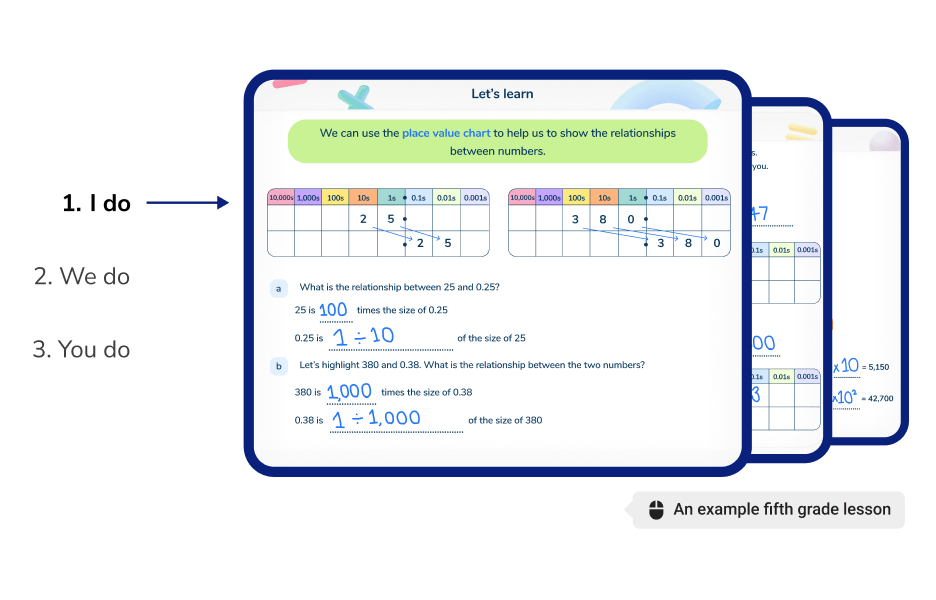

How it works in schools like yours
Personalized one-on-one online tutoring for multiple 5th graders at once, delivered by specialist 5th grade math tutors at a day and time that works for your school.
Book a free tutoring demo for your school or district
Explore the online classroom, preview lessons aligned to your state’s standards and see for yourself why 4,000+ schools like yours have chosen high impact one-on-one math tutoring from Third Space Learning:
Proven to accelerate math growth in half the time
2.4x cheaper than the average cost of one-on-one tutoring
Scalable and easy-to-implement across multiple grade levels and schools
Flexible scheduling according to your school and district’s needs
You can learn more about how we keep your data safe and secure in our privacy policy.
Frequently asked questions
How do you tutor a 5th grader in math?
To tutor a 5th grader in math, focus on reinforcing their understanding of 4th grade math, including spotting number patterns, multiplying fractions, using operations with decimals and percentages and multiplication and division of larger numbers. Practice problem-solving and critical thinking exercises within the math curriculum.
What math should a 5th grader be doing?
A 5th grader should be learning math concepts that include adding, subtracting, multiplying, and dividing fractions and decimals, understanding place value up to the millions, interpreting graphs and starting to explore basic algebraic concepts. They should also work on solving complex word problems, learning about volume and measurement, and continuing to develop their understanding of geometry and the properties of shapes.
What level of math level is taught in 5th grade?
In 5th grade, students typically learn advanced arithmetic with fractions and decimals, begin basic algebraic thinking with patterns and expressions, expand on geometry including volume and properties of shapes, and work with units of measurement and data interpretation. This level of elementary education prepares them for the transition to middle school math concepts and mathematical reasoning skills.
